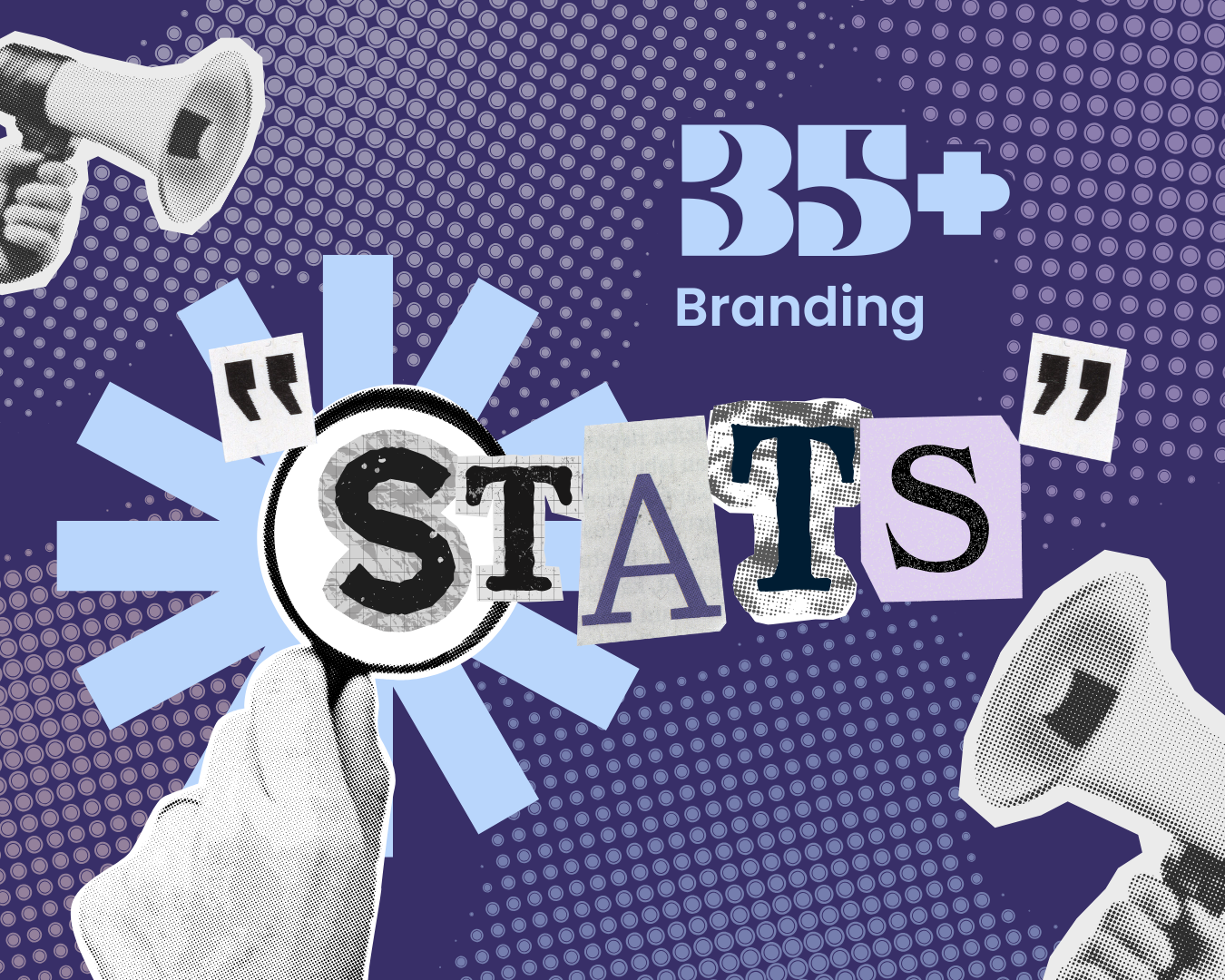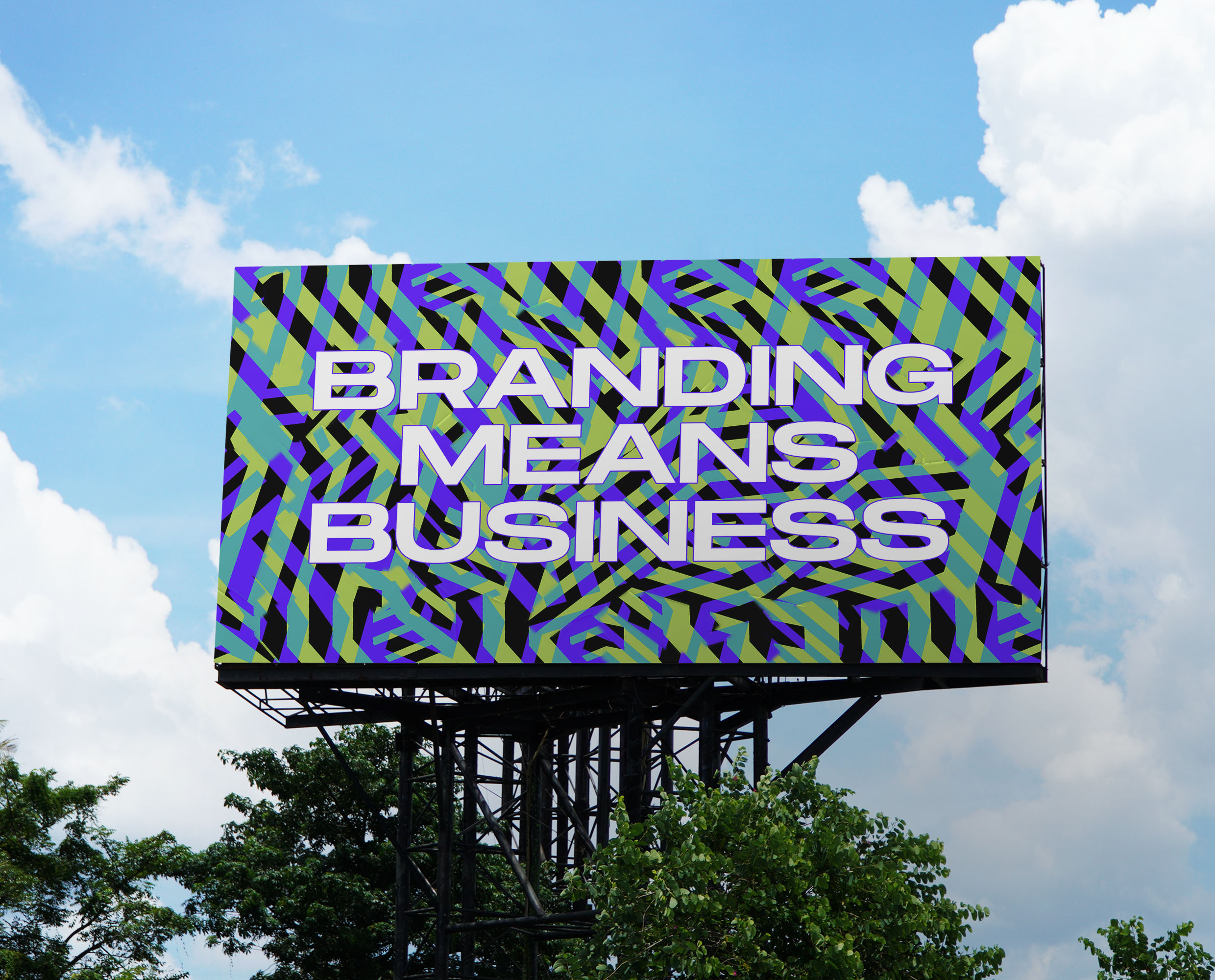
3.10.2025
35+ Must-Know Branding Statistics 2025 for Growth & Engagement
15 min read by Annabel Wood
Table of Contents
Intro
Branding in 2025 is as competitive as ever: the top 30 brands still own more than 80% of the industry, and AI is staking its claim to retire traditional branding models. But the human side of branding is still winning hearts. We’ll explore how showing up with consistency, care and cultural relevance means growth for brands.
This report lists 35+ bite-sized stats that spotlight essential tips for growth & engagement. From the power of first impressions to the influence of UGC and AI-led personalisation, the data is clear: effective branding = revenue.
Whether you’re launching a brand, debating the value of brand guidelines, or pushing for budget on that much-needed refresh, this is your ammo.
Let’s dive into the data.
Brand Design & Visual Identity
🎨 Starting with the foundations of a brand (logos, name, colours), how important is visual identity really? Research says…pretty important:
- It only takes 0.05 seconds for users to form an opinion about your brand, and 55% of brand first impressions are based on visual elements (Exploding Topics).
With less than a second to get across your brand’s purpose, personality and more, every ad and asset needs to grab attention. Bore consumers and you’ve lost them. Make them do a double take? You’ve earned yourself another 0.05 seconds.
- 75% of consumers recognise a brand by its logo over words or other cues (Zippia), emphasising the impact of visuals. Following logos, the most recognisable brand identifiers are visual style (60%), brand colour (45%), and unique voice (25%).
- But beyond first impressions, a consumer needs to see your brand on average 5-7 times before they remember it (also known as the Marketing Rule of Seven).
Brand Guidelines: Interestingly, 15% of companies have no brand guidelines at all (Lucidpress). Only 30% of brands have brand guidelines that are widely used/accessible across their organisation. And 77% of brands admit to publishing off-brand content at least occasionally. But does it matter? What are the 70% of brands without accessible guidelines really missing out on? Here’s what the numbers say:
- On average, maintaining brand consistency can increase revenue by 10–20% (Lucidpress).
- In a survey of over 400 company professionals, 32% said that consistent brand messaging drove revenue increases of more than 20%.
We get it, brand guidelines are an effort to create, and often require hiring a branding agency to do them right, but the payoff is worth it. Strong brand consistency means increased revenue, so not worth shortcutting. If you need a branding agency to handle all of this for you, check out OOB (we’d love to hear from you 👋).
👀 Fun fact: Hyundai is the most misspelt brand name online, misspelt around 605,000 times per month (Statista).
Social Media in Branding
Branding and social might have been separate once, but in 2025, social media is a huge part of ad spend. On average, brands allocate over a quarter of their total digital ad spend to social media marketing (Sprout Social).
💸 UGC and Influencer Marketing: User-generated content (UGC) has a major influence on buying decisions. 79% of people say UGC highly impacts their purchases, compared to only 12% for brand-created content, and 9% for influencer content (Influencer Marketing Factory).
📲 84% of consumers described UGC content as “extremely helpful”, and it’s easy to see why. Ever had your eyes on a product, but you’re just not quite sure if it will work as well as it claims to? UGC videos act like a 360 review, providing real insight and “social proof”.
Not only is this style of content helpful, it also feels more authentic than most ad forms:
- 59% of consumers rate UGC as the most authentic type of content a brand can use (Business Wire).
- 48% higher sales conversion rates are achieved by video ads compared to static image ads (Influencer Marketing Factory).
- 86% of shoppers prefer brands with an honest and authentic personality on social media (G2).
- 79% of Gen Z consumers have made a purchase based on an influencer’s recommendation.
🔎 Social Platforms as Search Engines: The user journey, from researching to purchasing, can now all be done in-app. Gen Z consumers opt for Instagram or TikTok to research brands, while Baby Boomers tend to stick with Google. Overall, Facebook is the top social platform that consumers use to research brands (Shopify).
💭 Why should my brand invest in social media?
According to Sprout Social, 77% of consumers prefer to shop with brands they follow on social media. Social media engagement drives brand loyalty: 68% of consumers follow brands on social to stay up-to-date on products/services, 46% follow for deals or promotions, and 45% follow for entertaining content. Striking the perfect balance between product, promotions, and entertainment is the foundation of a solid social strategy.
💭 Should our brand’s CEO be on social media?
Yes, 82% of customers say they trust a company more when its leadership (CEO/executives) is active on social media (Forbes). Use some sense here though – Gen Z will see through disingenuous marketing (Mark Zuckerberg, if you’re reading this, it’s too late to convince people that you’re a nice guy).
💭 Why should I hire a social media agency?
47% of marketers say they struggle to develop social media strategies that support their brand’s goals, and 70% list increasing brand awareness as their number one social media goal (Sprout Social). Working with a social media agency gives businesses access to expert, full-funnel social media marketing. Head here to see what a social agency could do for your brand.
The Power of Punchlines
One of the easiest and most underrated ways to make people fall in love with your brand is humour. In fact, 91% of consumers now say they actively prefer brands with a sense of humour (Oracle). And it’s not just about being liked: ads that land a laugh are 6x more effective at growing market share than those that don’t.
💭 Why does funny work?
At the brain level, we’re wired for joy. Specifically, things that are funny, surprising, or bring comical relief activate limbic brain regions which trigger the release of “feel good” neurotransmitters. On top of that, we’re no longer living in a time of polished perfection. With so much false or AI-generated content out there, audiences want realness, and humour is one of the most effective ways to bridge that gap. It signals confidence, relatability, and joy. Brands that get it right are rewarded with serious gains:
- 80% of people say they’re more likely to buy again from a brand that makes them laugh.
- 78% would even pay more for content that brings them joy.
And the numbers don’t stop there. 90% of consumers remember a funny ad, while 71% can name a brand that made them smile. These stats prove the power of funny to cut through unconscious consumerism, endless scrolling, and short attention spans. Make your audience laugh? They just might remember you.
But here’s the kicker: nearly half of consumers say they’d walk away from a brand that never makes them laugh, yet 95% of business leaders fear using humor in customer interactions (Oracle). Yes, brands need to be conscious of not offending consumers, but there are countless ways to make a joke without doing this, and playing it safe just might cost you.
Consumer Trust, Values & Loyalty
🛍️ Trust: Consumers who trust a brand are 2x more likely to be first to buy its new products, remain loyal and advocate for the brand. 87% of shoppers are willing to pay a premium for brands they trust, but only 1 in 3 consumers say they trust most of the brands they use (Edelman Trust Barometer).
🌍 Brand Values: 64% of consumers cite shared values with a brand as the primary reason for a brand relationship. When it comes to building trust, your brand’s values matter:
- 87% of global consumers will buy from a company that advocates for an issue they care about.
- 77% of consumers purchase from brands that share the same values as they do (Havas).
- Consumers are 4-6x more likely to trust, champion and defend companies with a strong brand purpose (Zeno).
🤝 Customer Retention & Loyalty: 89% of consumers become brand advocates after just one positive customer service experience, and 33% will switch to a competitor after one negative interaction.
💭 How does customer loyalty impact revenue?
Customer loyalty is actually a huge money saver. Winning a new customer costs 5x more than retaining an existing one, while a loyal customer can be worth up to 10x as much as a one-time customer due to repeat business and referrals.
Loyal brand advocates are consistent drivers of revenue:
- The probability of selling to an existing customer is 60–70%, compared to 5–20% for a new prospect.
- Existing customers spend on average 67% more than new customers.
- 80% of a company’s future revenue will come from just 20% of its existing customers (Firework).
Overall, just a 5% increase in customer retention can boost profits by 25-95%.The lesson? Don’t make the mistake of undervaluing loyal customers. Reward them instead to reinforce advocacy.
Industry Leading Brands
Apple remains the world’s most valuable brand, currently valued at around $1.3 trillion according to the latest BrandZ and Kantar data, making it the first brand to surpass the trillion-dollar mark in value. Top global brands in 2025 include: Apple ($1.3T), Google ($944B), Microsoft ($712.9B), Amazon ($576.6B), and McDonald’s ($221.9B).
Tech remains the world’s most valuable sector in brand equity, with a combined value exceeding $2 trillion. Retail brand value has also continued to surge, now regularly exceeding $1 trillion globally, and tech/AI-powered businesses are the fastest-growing category.
More than 80% of the cumulative brand value within the Interbrand top 100 is concentrated in fewer than 30 brands, underscoring the market dominance of global leaders.
AI & Personalisation
We can’t talk about branding in 2025 without mentioning AI. Now, 92% of businesses say they’ve integrated AI into their marketing in some way, and 88% of marketers use it routinely across segmentation, content creation and automation. Brands are investing more in personalised, data-led experiences, and it’s paying off:
- Tailored messaging can lift consumer spend by up to 38% and increase satisfaction by over 50%.
- Personalised calls-to-action convert over 200% better than generic ones.
- AI-driven email personalisation leads to a 29% jump in open rates.
But…as the use of AI grows, so does consumer distrust. Understanding audience perception is crucial: a brand’s use of AI can intrigue some audiences but alienate others if not handled transparently. A global study by Getty Images (covering 25 countries) found that nearly 90% of consumers want to know if an image was created using AI (Creative Brief), and 98% of consumers say “authentic” imagery is critical for building trust in a brand. The takeaway is clear: consumers want to know when AI is involved. Authenticity here means not only that images look real, but also that the brand is transparent when AI has been used (e.g. hashtags, labels, notes).
While tech’s evolving fast, brands should plan for audience perceptions to take a little longer to catch up. As conversations evolve around labelling, copyright, and disclosure, the brands that lead with honesty and intent will be the ones people trust.
FAQs 📌
Branding Statistics 2025
As well as logos and traditional TV ads, branding now also means UGC, AI, credibility threats, and more. In an era where AI is reshaping industries and consumer attention spans are shrinking, data-backed insights give brands the edge to make smarter decisions. These stats highlight what actually drives revenue and loyalty today.
A lot. Consumers form an opinion in just 0.05 seconds, and more than half of that impression is based on visuals. Logos, colors, and consistent style are the first brand meaning signals.
Yes. Companies with consistent branding see revenue increases of 10-20%. Yet only 30% of brands have widely used guidelines. Without them, you risk publishing off-brand content that dilutes your brand and costs money.
Because that’s where your customers are researching, shopping, and building loyalty. 77% of consumers prefer to shop with brands they follow, and social media now eats up over a quarter of digital ad spend. From UGC to influencers to CEOs being online, social is no longer optional, it’s the frontline of brand perception.
Absolutely. 91% of consumers prefer brands with a sense of humor, and funny ads are 6x more effective at growing market share. Neuroscience shows humor activates the brain’s reward system, making ads more memorable and brands more likable. Plus, 80% of people say they’re more likely to buy again from a brand that makes them laugh.
Trust is everything. Consumers with strong brand trust are 2x more likely to be first in line for new products, while 87% will pay more for trusted brands.
Both. On the one hand, 92% of businesses are using AI to personalise experiences, driving big jumps in spend, satisfaction, and conversions. On the other hand, nearly 90% of consumers want transparency if AI is involved. The takeaway: AI is powerful, but if you don’t disclose its use, you risk losing credibility.
Keeping a customer costs 5x less than acquiring a new one, and loyal customers are worth up to 10x more over their lifetime. Even a 5% increase in retention can boost profits by 25-95%. Investing in loyalty programs and customer care is one of the best moves a brand can make.
Tech still leads the pack. Apple ($1.3T), Google ($944B), and Microsoft ($712.9B) top the charts, with retail and AI-powered businesses rapidly growing. Over 80% of total brand value sits with fewer than 30 companies, showing just how competitive and concentrated the market is.





